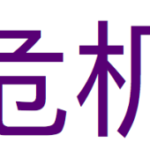 Although often hidden in the background, risk is interwoven into every aspect of our lives.
Although often hidden in the background, risk is interwoven into every aspect of our lives.
Given this inescapable reality, it is in our best interest to cultivate a sensible, and even cooperative, attitude toward it. Toward this end it may be instructive to consider the Chinese symbol for “risk” which is a combination of two ideograms, the one being “danger” or “crisis” and the other “opportunity.” In the West we know this as the risk/reward tradeoff.
 The goal is never to avoid risk altogether:
The goal is never to avoid risk altogether:
- because that’s impossible, given the realities of the world
- because without exposing ourselves to risk we cannot take advantage of the opportunities that it offers.
So, the question becomes, “How much danger am I willing to court, and what can I expect as a reward for the amount of risk I have taken on?” This question, and its answers, are at the heart of what we call “risk management.”
As fiduciaries entrusted to manage people’s retirement portfolios, our duty is to get the best return on investments that we can while minimizing the portfolios’ exposure to danger. In other words, what we do is “risk management.”
One of the most important factors when it comes to managing risk in a retirement portfolio is time. This concept of time is captured in our slogan “Investing for all seasons,” which refers to the seasons of one’s life; youth, maturity and old age. Youth, or young adulthood, is the time to take the maximum amount of risk. We leave home and either journey afar or begin a new endeavor such as starting a business or learning a craft. We have energy, enthusiasm that has not been tempered yet by life’s inevitable “hard knocks” and most of all, time. Time to recover from set backs and time to save for retirement. Young adults can and should take on the maximum amount of risk in their portfolios because they have the time to add to their savings as well as ride out the ups and downs of the market. These portfolios will have a large percentage in small and medium-cap stocks, international and emerging market stocks as well as investments at the leading edge of innovation where failure rates are high but one single investment can go from a garage start-up to a billion-dollar company in just a few short years.
With maturity comes responsibility, and with added responsibilities comes the need to mitigate risk. Our lives are more firmly interwoven with the community at large, and so a crisis in our own lives will impact those around us, whether it is our family, our church, or our partners in business. Because of our responsibilities to the community, we cannot be as reckless as we were in our youth and we must manage risk more carefully. Our retirement portfolio by this time will have grown substantially and the ability to replenish that portfolio, should anything happen to it, will be much more difficult. This is the time when insurance, one of the prime tools of risk management, plays its most important role. Portfolios at this time have to be more carefully calibrated and include less riskly investments like bonds, real estate, large-cap stocks and dividend payers.
For those in retirement, the goal is to minimize risk as far as possible but not to avoid it altogether, especially in the early years of retirement. We are all living longer; a fact that comes with its own risks and opportunities. Conventional wisdom says that a retiree should have a portfolio with very little risk. But this conventional wisdom was set when life expectancies were much shorter than they are now. Most of us will have a retirment that lasts at least 20 years, and many of us will have a retirement that lasts 30 years. That is a long time, and if we don’t want our money to run out during our lifetime we will have to accept more risk in our portfolio than maybe we’d like. Nevertheless, retirement is not a time to be taking on an extraordinary amount of risk. Retirement portfolios should have a minimum amount of exposure to small-cap and emerging market stocks. These investments may make a lot of money in the long run but their value can fluctuate wildly – losing 50% or more before recovering and making a profit. In the early years of retirement a portfolio should look substantially similar to that of the mature investor, but as a retiree reaches the age of 70 and 80, their portfolio should have the largest percentage to the safest investments such as bonds and even cash.
For those who are withdrawing from their portfolios on a monthly basis, a good strategy is to divide the assets in your retirement accounts into three or four “buckets.” The first bucket would comprise assets for your immediate needs, say for the next two or three years. This first bucket should have the safest investments like cash and short-term bonds. The second bucket would comprise assets that you will need in the near future, say from three to seven years. This bucket should have a portion to growth stocks and real estate, although not to the most volatile assets like small-cap and emerging market stocks. The third bucket will comprise assets for long-term growth and have the majority of its assets in volatile growth stocks like small-cap, emerging market and commodities. As your first bucket is depleted it is replenished from bucket number two and that bucket will, in turn, be replenished by bucket number three. By using this strategy you are “managing risk” in all its forms – harnessing risk to grow your assets in the third bucket and avoiding risk in the first bucket so that the money you need for immediate expenses is always there.
A 5,000-year old Chinese symbol offers relevant advice today because, as always, with risk there is opportunity and the trick is to manage it well.